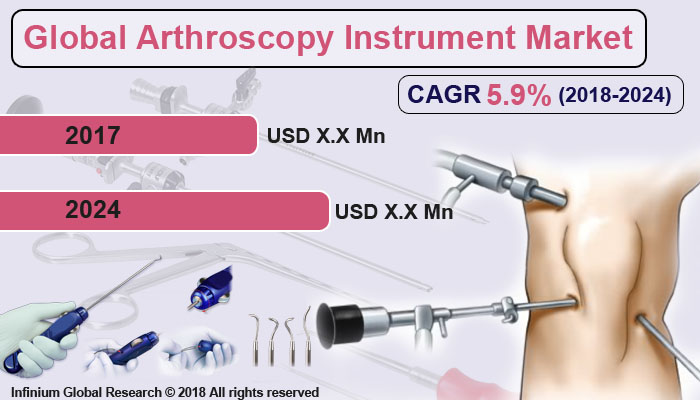Arthroscopy Instrument Market (Product Type - Arthroscopes, Arthroscopic Implants, Fluid Management Systems, Radiofrequency Systems, Visualization Systems, Power Shaver Systems, and Other Arthroscopy Equipment ; Application - Knee Arthroscopy, Hip Arthroscopy, Spine Arthroscopy, Foot and Ankle Arthroscopy, Shoulder & Elbow Arthroscopy, and Other Arthroscopy Applications; End User - Hospitals, Ambulatory Surgical Centers & Clinics, and Others):Global Industry Analysis, Trends, Market Size and Forecasts to 2024
A recent report published by Infinium Global Research on arthroscopy instrument market provides in-depth analysis of segments and sub-segments in global as well as regional arthroscopy instrument market. The study also highlights the impact of drivers, restraints and macro indicators on the global and regional arthroscopy instrument market over the short term as well as long term. The report is a comprehensive presentation of trends, forecast and dollar values of global arthroscopy instrument market. According to the report, the global arthroscopy instrument market is projected to grow at a CAGR of 5.9% over the forecast period of 2018-2024.

Market Insight
Arthroscopic surgical instruments
are designed to ease cutting and trimming with ergonomic designs and balanced
weight. They are used in procedures such as hand, hip, knee, shoulder, and
other small joint procedures. Arthroscopy is a surgical process implemented by
orthopedic surgeons to visualize, diagnose, and treat the problems in joints.
This process involves a small opening in the patient’s skin and inserts a
small-sized pipe instrument that contains a small lens and the light source
(fiber light) that is transmitted through fiber optics to examine the inside
structure of the joint. An arthroscopy device is generally used to examine the bone
joints for specific conditions such as rheumatoid arthritis, bone tumor, elbow
pain, and osteoarthritis.
Growing occurrence of
musculoskeletal disorders such as osteoarthritis and rheumatoid arthritis owing
to growth in the aged population and technological advancements are driving
factors for the arthroscopy instrument market. Furthermore, increasing in the
sports injuries where arthroscopy process avoids the total joint replacements
is projected to boost market growth. Additionally, the arthroscopic
implantation holds a leading share in the global arthroscopic devices market
and is predictable to maintain its lead over upcoming years. Moreover,
increasing demand for autonomous systems and robotics in arthroscopy
instruments for nominally invasive surgeries and the development of healthcare
expenses in developing countries act as future opportunities for this market.
But on the contrary, the high cost of arthroscopy instruments and the underprivileged healthcare system in developed and underdeveloped countries may
restrain the growth of this market.
In terms of geographic, North
America has dominated the arthroscopy instrument market followed by Europe and
the Asia-Pacific. In North America factors such as growing frequencies of
joint-related diseases, a high rate of sports-related surgery, and development
of advanced surgical instruments are driving the growth of this market in the
North America region. Further, improved reimbursement healthcare policies are
facilitating growth in North America. The growth in the Europe region is due to
the growing frequency of bone disorders and estimated government funding for research
and development is expected to drive the growth in this market. In addition, as
per the arthritis research U.K. in 2016, about 10 million people in the U.K.
had a form of arthritis and further, it was that above 86,000 hips and over
90,000 knee replacements take place every year. Some factors boost the growth
in the Asia-Pacific region is increasing in the aged population and on-going
progressive changes in healthcare infrastructure in the region.
Segment Covered
The report on global arthroscopy
instrument market covers segments such as product type, application, and end
user. On the basis of product type, the global arthroscopy instrument market is
categorized into arthroscopes, arthroscopic implants, fluid management systems,
radiofrequency systems, visualization systems, power shaver systems, and
another arthroscopy equipment. On the basis of application, the global
arthroscopy instrument market is categorized into knee arthroscopy, hip
arthroscopy, spine arthroscopy, foot, and ankle arthroscopy, shoulder &
elbow arthroscopy and other arthroscopy applications. On the basis of the end
user, the global arthroscopy instrument market is categorized into hospitals,
ambulatory surgical centers & clinics and others.
Geographic Coverage
The countries covered in the
North America region include the U.S., Canada, and Mexico; while Asia-Pacific
includes China, Japan, India, South Korea, Malaysia, and among others.
Moreover, Germany, U.K., France, Spain, and Rest of Europe are included in the
European region. The U.S. drives the growth in the North America region as it
is the largest market in the region. The Asia-Pacific region offers substantial
potential for the market growth owing to rapid growth in markets such as India
and China. The APAC region is projected to experience a growth at a CAGR of x.x%
over the period of 2018-2024.
Companies Profiled:
The report provides profiles of
the companies in the global arthroscopy instrument market such as Arthrex,
Johnson & Johnson, CONMED Corporation, Karl Storz GmbH, Medtronic Plc,
Richard Wolf GmbH, Smith & Nephew Plc, Stryker Corporation, Wright Medical
Group, and Zimmer Biomet Holdings, Inc.
Report Highlights:
The report provides deep insights
on demand forecasts, market trends, and micro and macro indicators. In
addition, this report provides insights into the factors that are driving and
restraining the global arthroscopy instrument market. Moreover, IGR-Growth
Matrix analysis given in the report brings insight into the investment areas that
existing or new market players can consider. The report provides insights into
the market using analytical tools such as Porter's five forces analysis and DRO
analysis of arthroscopy instrument market. Moreover, the study highlights
current market trends and provides forecast from 2018-2024. We also have
highlighted future trends in the arthroscopy instrument market that will impact
the demand during the forecast period. Moreover, the competitive analysis given
in each regional market brings insight into the market share of the leading
players. This report will help manufacturers, suppliers, and distributors of
the arthroscopy instrument market to understand the present and future trends
in this market and formulate their strategies accordingly.
